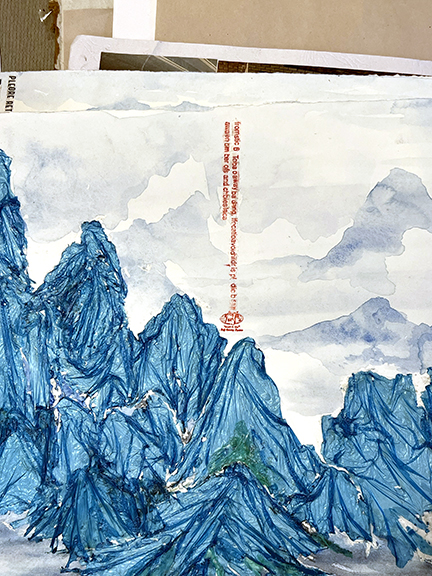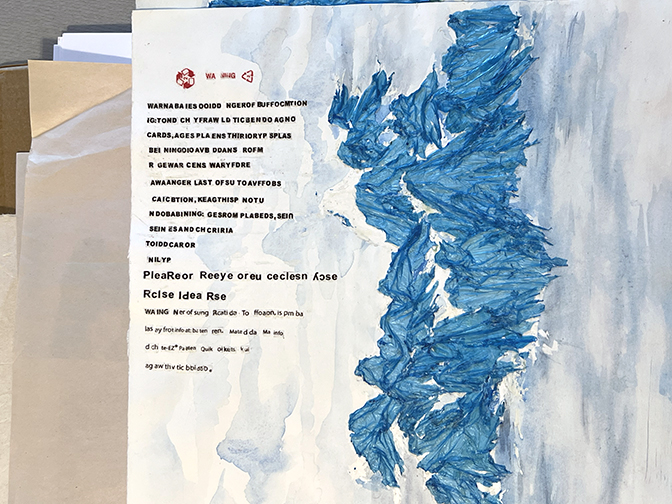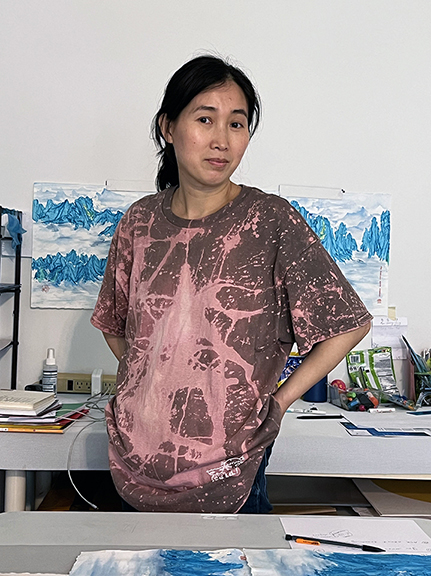Kun Zhao came to the United States after completing an MFA at the prestigious Tianjin Academy of Fine Arts to study at the School of the Art Institute of Chicago. During her studies, she was introduced to new methods for considering and advancing one’s aesthetic practice. Today, Zhao combines longstanding classical Chinese practices with contemporary disposable materials (e.g., plastics) to create complex artwork that address her concerns about consumerism and pollution. This week, The COMP Magazine trekked down to Chinatown to meet Zhao and discuss the role the arts played in her youth, the similarities and differences of art education in China and the U.S., how her studio practice utilizes found materials and traditional design approaches, and what her plans are for the remainder of 2024.

I believe you indicated your father teaches art in China. So, the arts were common in your youth. Can you share with us any early experiences you encountered that you see as impacting your decision to be an artist?
As long as I can remember, I watched my father painting at home almost every day. Although he never actively taught me, and I didn’t actively seek to learn or practice, I absorbed techniques like brushwork, ink mixing, color coordination, and composing from him. These skills were imprinted in my mind.
In high school, I commenced formal training in painting and drawing, a deep passion for art ignited within me. It was at that point I realized my calling to become an artist. It appears that the daily exposure to art during my childhood set the groundwork for my future decision to become an artist in the future.

You received a Master of Fine Arts from the Tianjin Academy of Fine Arts and continued your studies at the School of the Art Institute of Chicago. Do you see any significant differences or similarities in the art education approaches of these two institutions?
The art education approaches at the Tianjin Academy of Fine Arts and the School of the Art Institute of Chicago have both unique differences and notable similarities.
About the differences:
① Curriculum Focus:
- Tianjin Academy of Fine Arts emphasizes traditional techniques and disciplines, with a strong foundation in classical art forms and Chinese art history. There is a focus on technical skills and mastery of specific mediums.
- School of the Art Institute of Chicago (SAIC) offers a more interdisciplinary and contemporary approach, encouraging experimentation across various mediums and practices. There is a strong emphasis on conceptual thinking and critical theory.
- So, students at Tianjin Academy of Fine Arts tend to excel in techniques and realism, while students at SAIC are exposed to a broader range of artistic approaches and concepts
②Teaching Methods:
- Tianjin Academy of Fine Arts more structured and teacher-directed, with a focus on discipline and rigorous practice.
- SAIC encourages self-directed learning and critical discourse. Students are often given more freedom to explore and develop their unique artistic voices.
③ Cultural Context:
- Tianjin Academy of Fine Arts rooted in Chinese cultural and artistic traditions, reflecting local art movements and perspectives.
- SAIC reflects a diverse and global perspective, with exposure to a wide range of international art practices and contemporary issues.

Similarities:
Both institutions are dedicated to cultivating the growth of talented artists and offering exceptional education in fine arts. They are have renowned faculty members who are not only accomplished artists but also experienced educators. Each school provides a supportive environment that encourages creativity, innovation, and personal development.
These shared qualities ensure a rich and diverse foundation for students, merging traditional techniques with contemporary practices and a global perspective.
Supportive Environment. Both offer supportive environments that encourage creativity, innovation, and personal growth in their students.
These experiences provide a rich and diverse foundation for your artistic journey, blending traditional techniques with contemporary practices and global perspectives.

You work in a variety of printmaking processes (lithography, relief, monotype, screen printing). In addition, I see a range of approaches (abstraction, collage, realism) in your art practice. Can you discuss your approach to creating artworks? Specifically, how do you seethe idea informing the medium you are working in?
Each of my works stems from a desire to express personal feelings and ideas. When I have a concept in mind, I carefully consider which materials, media, and methods will most effectively communicate it. The choice of medium and technique is essential to fully articulate the idea behind the work.
My approach varies depending on the project. Sometimes I rely on familiar materials and techniques, while other times I explore new ones to achieve the desired effect. For instance, in my Rose Window collage, I addressed themes such as plastic waste, consumer culture, environmental pollution, and religion. The choice of materials and the collage technique were driven by these themes, resulting from a process of experimentation. Ultimately, I believe that the integration of ideas, materials, and techniques is crucial in conveying a cohesive message through my art.

I am currently working on a series of plastic landscape paintings where I use plastic garbage bags to mimic the style ofChinese freehand landscape paintings. Chinese paintings are divided into freehand and meticulous style. Chinese freehand painting focuses on conveying emotions brought by things, describing things in a general way, rather than detailed realism. This expressive approach attracted me and is one of the reasons I chose it as the theme for my creative work.
Additionally, Chinese painting symbolizes traditional Chinese culture and concepts. Through this work, I aim to illustrate the shift in concepts and ideas that are very different from the situation 20 years ago. For example, thrift was regarded as a traditional virtue of the Chinese nation in the past, but now contemporary consumption tends to pursue new things, eliminate old things, and shop at will (in terms of China). This change has given rise to modern waste materials such as plastic waste, industrial refuse, and abandoned shared bicycles from companies that have gone bankrupt.
In addition, I chose landscape as the theme because, in China, some hills around cities are made of garbage piles. Non-decomposable waste is heaped into mountains, covered with grass and trees, and transformed into picturesque landscapes. By using landscape as the theme, I aim to symbolize the relationship between waste and the environment. I hope that much like in my artwork, plastic waste can be properly handled and can coexist harmoniously with natural scenery.
This series explores the intersection of traditional Chinese culture with contemporary consumer materials. By employing plastic bags, I create a counterpoint to traditional Chinese painting, replacing the usual elements of poetry, calligraphy, seals, and imagery with plastic materials.

You are also working on a series of collages that look at draw materials from consumer culture. These highly visual active collages are dense and somewhat overwhelming. Can you discuss your interest incollage. How long have you been working upon this series?
Before creating the Rose Window pieces, I had never worked with the collage method. There are two pieces in this series, each taking about six months to complete. The daily plastic packaging waste overwhelmed me, and these packages’ beautiful colors simultaneously attracted me and inspired me.
These dense dots represent the light spot effect I am aiming for, while also incorporating the pointillism technique of Impressionism. By blending these two approaches and considering color theory and matching, I aim to create rich visual effects and intricate color layering.
These works aim to reflect the impact of human consumption on the environment, ecology, religion, and spirit. Today, the environmental issues associated with consumerism are becoming increasingly prominent. Through the form of the Rose Window, I seek to express the historical roots of changes in consumer culture and behavior.

What do you value most in your aesthetic investigations and studio practice?
In my aesthetic research and creation, I prioritize expressing what truly touches and inspires me, aiming to create works that evoke deep thoughts and emotions. I find joy in discovering and creating beauty from the mundane, transforming ordinary things around me into art. This approach mirrors the way ordinary people strive to live a more brilliant life, working hard bit by bit to create beauty in their own lives.

In addition to working as an artist, you have taught art. Are there any recurring items you see yourself discussing with your students? Do you see teaching having any impact are your studio practice?
We often discuss how to appreciate contemporary art and explore painting and drawing theories. In China, there is an old saying, “教学相长,” which means that while students gain knowledge and skills from their teachers, teachers also deepen their understanding and improve their teaching through interactions with students, even gaining inspiration and new ideas from them. This is why I love and enjoy teaching. I appreciate this state of mutual stimulation.

What are you currently working upon? What is the plan for the remainder of 2024?
Currently, I am working on watercolor pieces and sketches. For the remainder of 2024, I plan to prepare the materials for my O-1 visa application, and I hope to obtain the O-1 visa by the end of the year.

For additional information own the studio practice of Kun Zhao, please visit:
Kun Zhao – https://www.kunzhao.art
The School of the Art Institute of Chicago – https://sites.saic.edu/gradshow2023/artists/kun-zhao/
Linked In – https://www.linkedin.com/in/kun-zhao-225a74268

Artist interview and portrait by Chester Alamo-Costello


